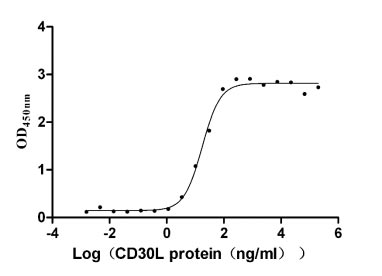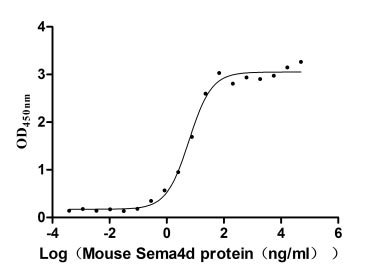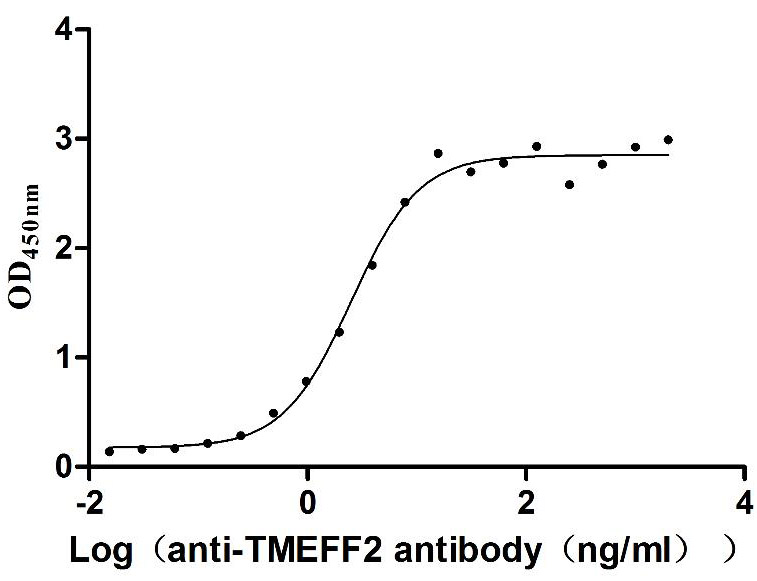Recombinant Mouse Calcium-activated potassium channel subunit beta-1 (Kcnmb1), partial
-
货号:CSB-YP807479MO
-
规格:
-
来源:Yeast
-
其他:
-
货号:CSB-EP807479MO
-
规格:
-
来源:E.coli
-
其他:
-
货号:CSB-EP807479MO-B
-
规格:
-
来源:E.coli
-
共轭:Avi-tag Biotinylated
E. coli biotin ligase (BirA) is highly specific in covalently attaching biotin to the 15 amino acid AviTag peptide. This recombinant protein was biotinylated in vivo by AviTag-BirA technology, which method is BriA catalyzes amide linkage between the biotin and the specific lysine of the AviTag.
-
其他:
-
货号:CSB-BP807479MO
-
规格:
-
来源:Baculovirus
-
其他:
-
货号:CSB-MP807479MO
-
规格:
-
来源:Mammalian cell
-
其他:
产品详情
-
纯度:>85% (SDS-PAGE)
-
基因名:
-
Uniprot No.:
-
别名:Kcnmb1Calcium-activated potassium channel subunit beta-1; BK channel subunit beta-1; BKbeta; BKbeta1; Calcium-activated potassium channel; subfamily M subunit beta-1; Calcium-activated potassium channel subunit beta; Charybdotoxin receptor subunit beta-1; K(VCA)beta-1; Maxi K channel subunit beta-1; Slo-beta-1; Slo-beta
-
种属:Mus musculus (Mouse)
-
蛋白长度:Partial
-
蛋白标签:Tag type will be determined during the manufacturing process.
The tag type will be determined during production process. If you have specified tag type, please tell us and we will develop the specified tag preferentially. -
产品提供形式:Lyophilized powder
Note: We will preferentially ship the format that we have in stock, however, if you have any special requirement for the format, please remark your requirement when placing the order, we will prepare according to your demand. -
复溶:We recommend that this vial be briefly centrifuged prior to opening to bring the contents to the bottom. Please reconstitute protein in deionized sterile water to a concentration of 0.1-1.0 mg/mL.We recommend to add 5-50% of glycerol (final concentration) and aliquot for long-term storage at -20℃/-80℃. Our default final concentration of glycerol is 50%. Customers could use it as reference.
-
储存条件:Store at -20°C/-80°C upon receipt, aliquoting is necessary for mutiple use. Avoid repeated freeze-thaw cycles.
-
保质期:The shelf life is related to many factors, storage state, buffer ingredients, storage temperature and the stability of the protein itself.
Generally, the shelf life of liquid form is 6 months at -20°C/-80°C. The shelf life of lyophilized form is 12 months at -20°C/-80°C. -
货期:Delivery time may differ from different purchasing way or location, please kindly consult your local distributors for specific delivery time.Note: All of our proteins are default shipped with normal blue ice packs, if you request to ship with dry ice, please communicate with us in advance and extra fees will be charged.
-
注意事项:Repeated freezing and thawing is not recommended. Store working aliquots at 4°C for up to one week.
-
Datasheet :Please contact us to get it.
靶点详情
-
功能:Regulatory subunit of the calcium activated potassium KCNMA1 (maxiK) channel. Modulates the calcium sensitivity and gating kinetics of KCNMA1, thereby contributing to KCNMA1 channel diversity. Increases the apparent Ca(2+)/voltage sensitivity of the KCNMA1 channel. It also modifies KCNMA1 channel kinetics and alters its pharmacological properties. It slows down the activation and the deactivation kinetics of the channel. Acts as a negative regulator of smooth muscle contraction by enhancing the calcium sensitivity to KCNMA1. Its presence is also a requirement for internal binding of the KCNMA1 channel opener dehydrosoyasaponin I (DHS-1) triterpene glycoside and for external binding of the agonist hormone 17-beta-estradiol (E2). Increases the binding activity of charybdotoxin (CTX) toxin to KCNMA1 peptide blocker by increasing the CTX association rate and decreasing the dissociation rate.
-
基因功能参考文献:
- Whole-cell currents density of BK channels and amplitude of spontaneous transient outward currents were significantly reduced in hypoxia vascular myocytes. PMID: 29486465
- Study showed that in human and rat arterial myocytes, membrane depolarization rapidly increased the cell surface abundance of auxiliary BK beta1 subunits but not that of the pore-forming BKalpha channels. Membrane depolarization stimulated voltage-dependent Ca(2+) channels, leading to Ca(2+) influx and the activation of Rho kinase (ROCK) 1 and 2. PMID: 28487419
- Expression of vascular large-conductance calcium-activated potassium channel Kcnmb1 is regulated by Nrf2 signaling. PMID: 28429615
- 7-Ketocholesterol induces the reduction of KCNMB1 through the AhR pathway. PMID: 25576871
- BK channel activity directly affects vascular tone but influences blood pressure independent of this effect via different pathways PMID: 24687584
- up-regulation of NF-kappaB-dependent MuRF1 expression is a novel mechanism that leads to BK channelopathy and vasculopathy in diabetes PMID: 24570002
- Our results support a model whereby subcellular anchoring of CaN by AKAP150 is a key molecular determinant of vascular BKCa channel remodeling, which contributes to vasoconstriction during diabetes mellitus. PMID: 24323672
- The activity of BKbeta1 is higher in cerebral smooth muscle cells compared to pulmonary artery. PMID: 23426969
- The results indicate that the beta1-subunit can form a tripartite complex with TP and MaxiKalpha, has the ability to associate with each protein independently. PMID: 23255603
- BK channels play a prominent role in smooth muscle function only in the distal colon of mice. Defects in smooth muscle BK channel function disrupt colonic motility causing constipation. PMID: 22830588
- Impaired sodium excretion resulting form loss of normal purinergic regulation of ENaC in BK-beta4 null mice likely contributes to their elevated blood pressure PMID: 23002235
- Vascular smooth muscle cell cholesterol and BK beta1 are both required for ethanol inhibition of BK and resulting cerebral artery constriction, with health-related implications for manipulating cholesterol levels in alcohol-induced cerebrovascular disease. PMID: 21868700
- these results suggested that oxidative stress inhibited Akt signaling and facilitated the FOXO-3a/FBXO-dependent BK-beta(1) degradation in diabetic vessels. PMID: 22586590
- Reduced vascular BK channel function does not protect against hypotension in the early stage of septic shock; in the later stage, smooth muscle BK channel deficiency enhances organ damage and mortality PMID: 21997262
- BKbeta4 and to a lesser degree BKbeta1 transcripts and protein are detected in several astrocytic populations and cultured cells. PMID: 21438011
- enhanced tracheal contraction of the BK beta1 knockout can be ascribed to a defect in BK channel opposition of M2 receptor-mediated contractions PMID: 21300746
- The results indicate that BK beta1-KO mice are not hypertensive on normal or high-salt intake PMID: 21131476
- Results reveal the first ion channel subunit as a direct target of SRF-MYOCD transactivation, providing further insight into the role of MYOCD as a master regulator of the SMC contractile phenotype. PMID: 19801679
- The large conductance potassium channel beta-subunit can interact with and modulate the functional properties of a calcium-activated chloride channel, CLCA1 PMID: 11994272
- the beta1-subunit of BK(Ca) contributes to the increased glomerular filtration rate that accompanies an acute salt and volume load and raises the possibility that it is also involved in regulating K(+) excretion under these conditions PMID: 12620927
- BK channels have a central role in urinary bladder function PMID: 15184377
- the BK-beta1 accessory subunit is present in the connecting tube segment of the mammalian distal nephron and has a significant role in the kaliuretic response to increased urinary flow induced by volume expansion. PMID: 15613616
- the effect of tamoxifen on arterial KCa channels does not depend on the presence of the beta1 subunit PMID: 15826942
- Although the functional interaction of alpha and beta1 requires the N-terminal tail of alpha, the physical association requires the S1, S2, and S3 transmembrane helices of alpha PMID: 16549765
- Beta1-subunit is required in airway smooth muscle for control of voltage-dependent Ca2+ influx during rest and after cholinergic signaling in BK channels. PMID: 16632519
- Deglycosylation of BK channels did not affect the conductance but shifted the steady-state voltage of activation toward more positive potentials without affecting slope when Ca(2+) concentration was <1 microM. PMID: 16738006
- Report role of BKbeta1 in Na+ reabsorption by cortical collecting ducts of Na+-deprived mice. PMID: 19458125
- adaptation to hypoxia exerts a protective role on cardiomyocytes subjected to ischemia and that, unexpectedly, this form of preconditioning absolutely depends on Hif-2alpha. PMID: 19461047
- The majority of the hypertension of Kcnmb1(-/-) is due to aldosteronism, resulting from renal potassium retention and hyperkalemia. PMID: 19556540
显示更多
收起更多
-
亚细胞定位:Membrane; Multi-pass membrane protein.
-
蛋白家族:KCNMB (TC 8.A.14.1) family, KCNMB1 subfamily
-
组织特异性:Expressed in many tissues containing smooth muscles. In brain and heart, it is not expressed except in the vasculature, such as cerebral arteries, aorta and corona arteries.
-
数据库链接:
KEGG: mmu:16533
STRING: 10090.ENSMUSP00000020362
UniGene: Mm.6206
Most popular with customers
-
Recombinant Human Tumor necrosis factor receptor superfamily member 8 (TNFRSF8), partial (Active)
Express system: Mammalian cell
Species: Homo sapiens (Human)
-
Recombinant Mouse Semaphorin-4D (Sema4d), partial (Active)
Express system: Mammalian cell
Species: Mus musculus (Mouse)
-
Recombinant Human Complement component C1q receptor (CD93), partial (Active)
Express system: Mammalian cell
Species: Homo sapiens (Human)
-
Recombinant Human Tomoregulin-2 (TMEFF2), partial (Active)
Express system: Mammalian cell
Species: Homo sapiens (Human)
-
Recombinant Human Claudin-3 (CLDN3)-VLPs (Active)
Express system: Mammalian cell
Species: Homo sapiens (Human)
-
Recombinant Human Transferrin receptor protein 1 (TFRC), partial (Active)
Express system: Mammalian cell
Species: Homo sapiens (Human)
-
Recombinant Human CD81 antigen (CD81), partial (Active)
Express system: Mammalian cell
Species: Homo sapiens (Human)
-
Recombinant Mouse Cytotoxic and regulatory T-cell molecule (Crtam), partial (Active)
Express system: Mammalian cell
Species: Mus musculus (Mouse)




















